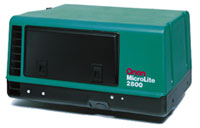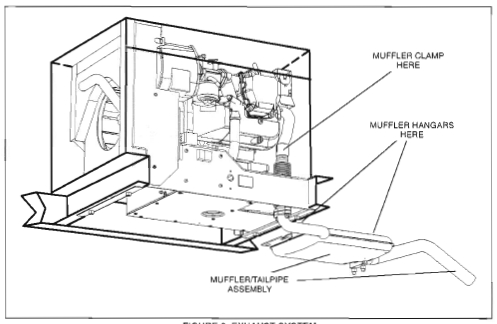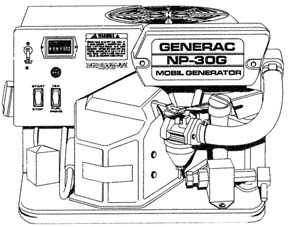|
On this page:
ONAN Micro-Lite Generators
 The
electric generator is probably the biggest cause of headaches for Rialta owners.
The model used is the smallest and most compact of the product line of the manufacturer,
either Onan or Generac. This means that it also is the cheapest of the entire line. The
electric generator is probably the biggest cause of headaches for Rialta owners.
The model used is the smallest and most compact of the product line of the manufacturer,
either Onan or Generac. This means that it also is the cheapest of the entire line.
The culprit of the most problems with the generator is alleged
to be "varnish" in the carburetor and fuel system thereby causing it not to start
or fail to keep running. Supposedly, if you allow the vehicle to sit idle for
several weeks, then the varnish from the gasoline begins to appear. To me it is
unclear why such a varnish problem does not affect many other small generators
used throughout the construction and piping industries. Regardless, no warranty
coverage is afforded for problems in which varnish is diagnosed to be the cause.
One thing to note about losing output power is that according
to Onan's brochure, for every 1,000 feet in altitude above sea level, you will
lose 3-1/2% power and 1% for each 10 degrees above 85 degrees ambient. What this
means is that while at a campground that is at 7,000 feet, you will lose 7 x 3.5
or 24-1/2% power loss. Your 2,800 watt generator just became a 2,114 watt generator.
Similar results, though somewhat less loss, will occur when ambient air temperature is near 100 degrees or
more.
One sure-fire solution to the "varnish" problem appears to
be the installation of a fuel-cut off valve in the gas feed line to the generator.
Before shutting off the generator for storage, the valve is closed and no additional
gas is fed to the generator. The generator is then allowed to run until it uses
up all the fuel in the carburetor and fuel bowl. The thinking is that varnish can't
form where there is no gasoline present. For information about installing a fuel
cut-off valve, see the menu item "Modifications".
ONAN Micro-Lite 2800 Spec Sheet (171KB PDF)
ONAN General Information (1.84MB PDF)
ONAN Owner's Handbook (1.24MB PDF)
ONAN KV, KVC, and KVD Parts Manual (1.94MB PDF)
ONAN KV, KVC, and KVD Service Manual (4.09MB PDF)
ONAN KVC Installation Manual (740KB PDF)
ONAN KVC Operator Manual (430KB PDF)

A few pictures of the air filter installation:



The original Onan spark plug is a Champion RL95YC.
[ return to top ]
Generac

The first model years of Rialta utilized a Generac generator
instead of the more current Onan brand. The Generac company began to phase out
these small generator sets which were used solely on the Rialta so Winnebago switched
to the ONAN brand beginning in model year 2000.
I've been told that as of May 2006 there are no longer any
factory parts available for these so either existing used parts must be found
or the entire unit replaced with the newer model Onan generator. In fact, carburetors, starters, air
filters, mufflers, oil filters, spark plugs, solenoids, fuel pumps,
gaskets, and many other parts are readily available, some even from
Generac themselves, though prices often tend to be on the high side. There are also a few places
that list parts that they don't have.
Generac Parts Quick Reference Chart (11.2KB PDF)
Owner's Manual and
Installation Instructions (Model 0661-1) (5.79MB PDF)
Owner's Manual and
Installation Instructions (Model 0661-2) (6.58MB PDF)
Owner's Manual and
Installation Instructions (Model 0661-3) (7.41MB PDF)
Owner's Manual and
Installation Instructions (Model 0661-4) (3.44MB PDF)
Owner's Manual and
Installation Instructions (Model 0661-5) (2.18MB PDF)
Owner's Manual and
Installation Instructions (Model 0940-1 and 0941-1) (4.95MB PDF)
Owner's Manual and
Installation Instructions (Model 0940-2 and 0941-2) (4.20MB PDF)
Owner's Manual (Model 9557-0 and 9557-1) (2.61MB PDF)
Service Manual (Model 0940-2 and 0941-2) (3.32MB PDF)
Service Manual (early Model NP-30G) (4.53MB PDF)
Diagnostics Manual for NP-45G, -55G, and -65G (2.73MB PDF)
Good troubleshooting and test procedures, though not all apply. Does not include the Genistor module.
[ return to top ]
Starting Tips:
There has been much discussion about generators which will turn
over but not start. Check the following, not in any particular order:
-
Start the engine on the Rialta then try to start the generator.
If this works, it means your coach batteries are weak.
-
Do you have more than one quarter tank of gas? There is an auto
shut-off feature of the generator when the gas tank gets below one quarter tank
as a safety measure so you do not get stranded someplace. Don't depend on this though because
not all pickup tubes were inserted to the same depth.
-
Is the oil level in the generator up to the proper level? Improper
oil level and generator will not start. Another safety measure. Some models have
a trouble-prone oil sensor which the factory is recommending to be disconnected.
-
Are you parked on a relatively level surface? Again, gas or oil.
-
Have any repairs been made to the unit which involved the gas
line, gas tank, generator or generator gas line? Maybe the pick up was not replaced.
-
Is the pickup in the gas tank for the generator plugged with "stuff"?
-
Is the start switch on the panel shorted? Don't forget, that is
how one stops the generator and if the stop switch is stuck, then the unit will
never start and continue to run.
-
Is there a manual cutoff for the gas and or the run switch someplace
in the circuit/gas line which prevents the generator from going to the run mode?
-
Have checked the spark plug and wire?
-
Have you removed the spark plug, tried to start the engine, and
checked to see if you are getting fuel into the chamber? To do this, disconnect
spark plug wire, try to start generator, remove plug and check for gas on end.
No gas, no start.
[ return to top ]
| 